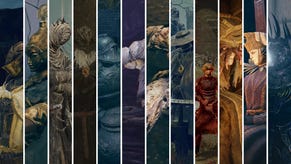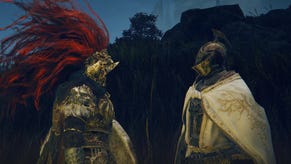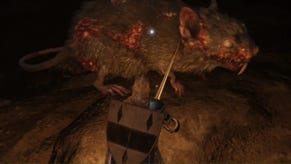Elden Ring: Shadow of the Erdtree review - a visually resplendent living text made less alive
Tarnished.
My first steps into the Shadow Realm are with bare feet and an empty head. After reaching out to Mohg's crusty egg, I materialise in a vast, rolling field dotted with ruins. In the distance is a dimmed, sickly twin of the Erdtree ringed by shadowy drapes. It takes a minute to remember my buttons, but I summon Torrent to sprint through the long grass like a dog being let off the leash, and almost immediately experience death from above – some gnarled freak just two-shot me into the dirt. It takes a while to get a rhythm going again, and sort out whatever I was trying to do with my NG+ build. I decide for the sake of efficiency to stick to my Moonveil/Carian Glintstone Staff setup, because one does not simply walk into a FromSoft DLC.
It takes more time to feel at home again, but soon I'm puncturing hearts and obliterating minds, executing small huddles of gibbering NPCs as they pray, finding ways to slip past hard-hitting knights. Everyone I meet is all about Miquella, and it's a lot, but such is the way of the cult. Miquella has left crosses scattered about the Shadow Realm for his devotees, to denote where he has shed parts of himself and his flesh; Jesus himself couldn't have pulled off this kind of postmodern brand campaign.
Eventually I find myself in the Specimen Storehouse, which is in many ways a classic convoluted FromSoft library/lab level, and perfectly in line with Elden Ring's weird fascination with eugenics and taxonomy. There are many artefacts here, including a preserved giant suspended face-down from the ceiling, a waistcloth draped over his rump. As soon as I see him, I am seized with wild Miquellan fervour and run behind him to write "hole ahead." I am the first to write this here; I am message-seeding for the most prominent hole in the game like an enterprising SEO writer. Later, as I'm about to get evaporated by a boss, my message gets a "like" that saves my life. We're so f***ing back.
Until we aren't.
It's been almost two years since I last touched Elden Ring, which I loved when it came out in early 2022. With so much of the game dissected, analysed, and overanalysed by players and critics since its release, going into this DLC is a very different, and necessarily loaded experience. With Elden Ring we all went in blind as newborn kittens and learned to read the land slowly and surely until it became familiar. Shadow of the Erdtree is framed around a much more explicit mission: to find Miquella, or at least figure out what happened to him after Mohg snatched him.
The Shadow Realm itself offers variations on the same aesthetic themes of Elden Ring – expansive plains, dense clumps of forest, hulking fortresses, and of course, pockets of everyone's favourite poison swamps. There are five main regions, each with their own small terrors, but it's all signature FromSoft-designed terrain that demands careful scrutiny for hidden paths and other secrets. Despite entering this world to discern Miquella's fate, I am, like in the core base game, technically free to run around wherever I can; I choose to focus on the first big "legacy dungeon" in the starting area, the castle-like settlement of Belurat, and the slow process of learning where and when to slash and run and duck. As I explore more of the map, I realise that there's a strange sense of emptiness – or at least, irregular organisation and grouping of lore-relevant areas and mobs – that pervades the Shadow Realm. There's certainly a lot of new terrain to cover, but many portions of the map feel like too-dead space in ways that the core game (mostly) mitigated through novelty, and to a lesser extent, more varied encounters like evergaols.

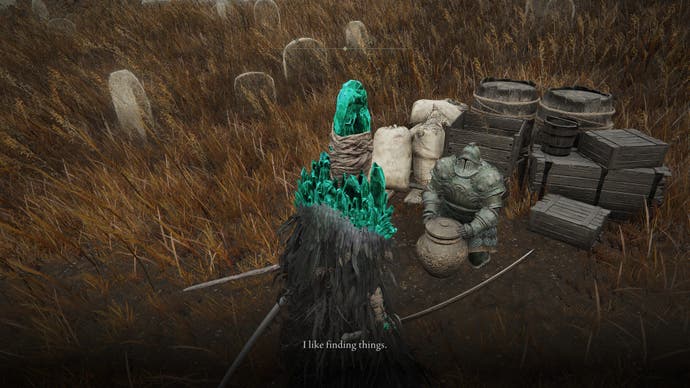
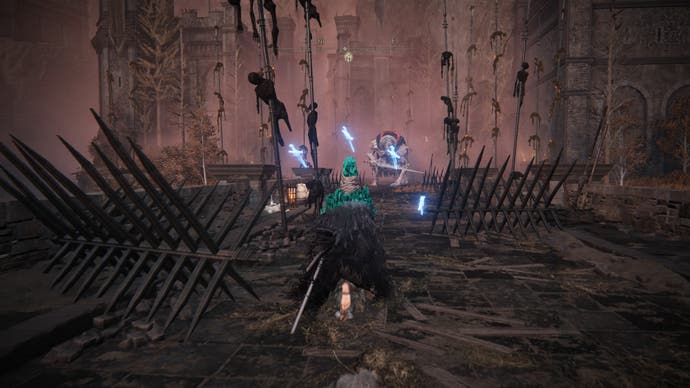
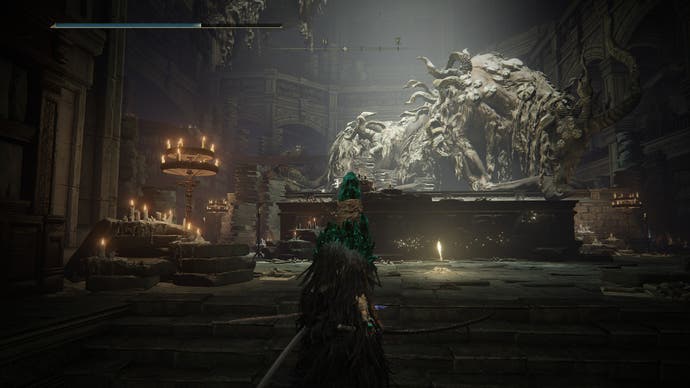
While early parts of Gravesite Plain feel like a slightly jaundiced, muddier version of the Elden Ring palette, everything is still exquisitely beautiful. It continues the same visual language of the core game – a profound understanding and mastery of light and colour theory drawn from a long line of European religious art and architecture. There's the continued influence of at least two Gustavs (Moreau and Doré) as well as the usual suspects (William Blake, a touch of pre-Raphaelite vibes, Arthur Rackham, the list goes on). The Ancient Ruins of Rauh is a verdant jungle-infused hell interspersed with cavernous tunnels – there's a real sense of relief in bursting out into greenery after being cornered by mobs in dangerously musty halls – that offers a stunning panoramic view of the Shadow Realm's mysteries. Even the Abyssal Woods turns a dark and mostly ominous grey forest palette into something magnificent and distinctly humbling. The most photogenic, though, are the two hidden areas in the south – the Cerulean Coast and Charo's Hidden Grave, blue-and-red flower-strewn siblings nestled almost on top of each other. Both are stunning, and seem partly inspired by the symbolism of red and blue in Biblical art, particularly Marian blue, which ties back to the themes and narrative beats of the game.
The DLC has two new items – Scadutree Fragments and Revered Spirit Ashes – to bolster my Tarnished, but they're only effective in the Shadow Realm (to this end, there is no real need to go back to Roundtable Hold unless you want to beef up the handful of new DLC spirit ashes or upgrade weapons). Collecting the former offers a substantial boost to both my damage output and damage negation, and the latter does the equivalent for my Spirit Ashes. It became clear after my early jaunts around Gravesite Plain that I was going to need them – despite my substantial health bar, the first few hours felt like I was on Naked and Afraid whenever I met a new type of enemy, or made small but costly misjudgments. Besides these new items – and a new martial arts combat style courtesy of fellow Miquella enthusiast, Dryleaf Dane – combat and mechanics are mostly business as usual. The first three major bosses are challenging, but readable and learnable. The difficulty discrepancy between those and the fourth boss, though, was brutal. So far, so Souls.

Throughout the open world, there are also gargantuan new enemies, Furnace Golems, which I didn't mess with too much because across this DLC there was simply so much to do. What I did learn is these are enormous basket-headed machina that only take damage at precise points (like their comically small faceplates); they can also spot you from miles away and start spewing dinosaur-ending amounts of fireballs. Unfair bastards – but totally avoidable, if you don't mind missing out on new mixtures for the Wondrous Physick. The best way to deal with Furnace Golems is to hurl Hefty Pots into their "basket" receptacles, but frankly I didn't have the time to commit to that. My priority here was seeing as much of Shadow of the Erdtree as I could, and so to this end I mostly stuck with variations of what I knew. In an ideal world, perhaps I could have found some wildly experimental build to mess around with and actually have a little fun. But as an astrologer rocking an int/dex build, there aren't many good upgrades for me in the early game – at least nothing that could beat what I already had, especially my faithful Mimic Tear.
My hole-induced high from the Specimen Storehouse doesn't last for long, though there are still moments of wonder and admiration whenever I stumble across gorgeous new scenery or unacceptable (yet inspirational) quantities of fingers. My favourite point of intrigue so far is the Church of Manus Metyr and its cheery resident, Ymir, who tasks me with finding a special ruin that turns into a minor obsession. This is a subquest for finger sickos, and it pays off in both visual spectacle and finger-sicko humour. There are also small threads of conspiracy between the NPCs I meet – Miquella's band of followers – that will take time to unravel, as the game sporadically offers me decisions that impact the way I interact with them. I feel like it'll take multiple playthroughs to really map out their relationships, which will be an important task for a more patient player than I.


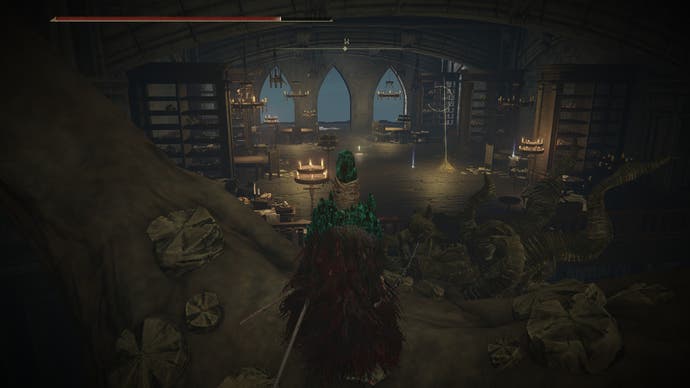
One of my biggest issues with this DLC is how explicitly it abandons the core appeal of Elden Ring as a living text to be read and learned, and ambiently, lovingly communicated across realms through vague multiplayer messages. The actual lore – the stuff behind the Elden Lord, Marika, the fingers et al – is not too hard to understand. What I'm talking about is the way players perceive and experience the world, and how they move through it using an evolving body of hard-won knowledge – including the knowledge that others are failing, but persisting – that defines a fundamental aspect of Elden Ring's gameplay. It's really hard to maintain that sense of growth and tension when the DLC undermines the hallmarks of its own genre through unnecessary signposting (and to an extent, the unavoidable linearity of a DLC that revolves around one clear premise).
At one point, I enter a dungeon with an "official" message at the entrance, explicitly directing me to "hit them where they're weakest," referring to the dungeon's golem-like constructs. This is not a directive anyone wants to see in a FromSoft game; it is difficult to imagine someone making it this far in a Souls game and not understanding the point of a conspicuously red gaping hole in a large monster. The worst is out in the Abyssal Woods, which takes some of the most obnoxious pages out of Bloodborne's book – it's a stealth-focused region that announces its gimmick via multiple official messages, that spell things out to the player as one would a child. One would think that FromSoft would let me learn through my own suffering, but at its worst here I feel like I'm reading an even more simplified version of The Minpins, a children's story about a small boy who has to evade an unknown horror in the forest.
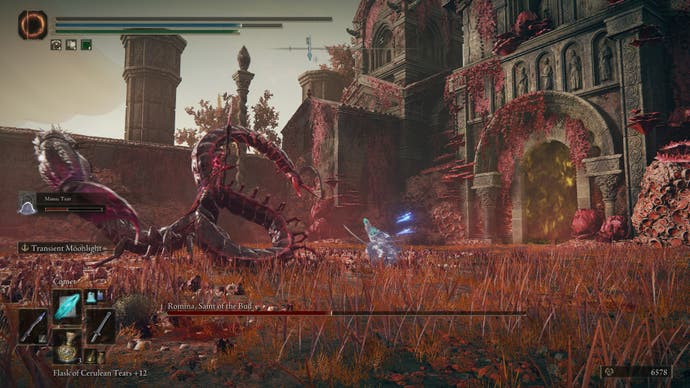
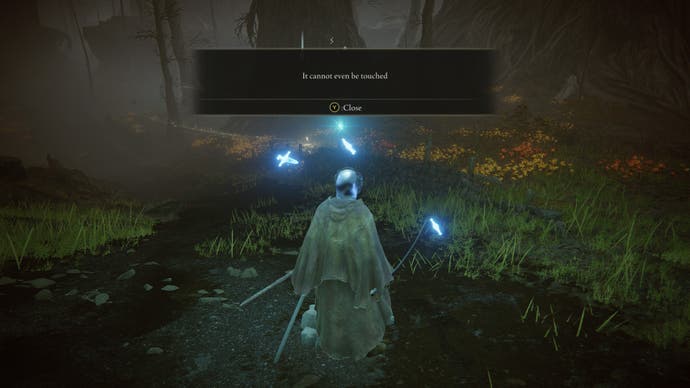

"Do not let it see you", reads one message, and so I immediately put on my silencing talisman so that I can creep around comfortably. Another message - "it cannot even be touched!" - implies that I shouldn't even try. A huge part of Souls games is intuiting and adapting (and deciphering other players' cryptic warnings), not reading a clear instruction and avoiding the lesson entirely. The result of all this signposting is that the Abyssal Woods' early warning setup essentially defangs itself, in a way that feels totally counterintuitive to the spirit of the game. Compounding the issue is how the creatures of the Abyssal Woods themselves are also a thinly reheated Bloodborne concept – I won't spoil which exactly – and so all together the entire area ends up feeling like an empty disappointment.
Like any Soulslike, there are times where I have to walk away from a boss fight before I get shamefully tilted. This has never been more true than for the final boss in Shadow of the Erdtree, which I make 49 miserable attempts to kill before realising I have to set it aside for now (my best efforts got it down to around 30 percent health). Most Elden Ring boss fights are scripted to punish the player for drinking flasks – as a friend rightfully pointed out, they will literally cancel animations to accomplish this – but this particular fight seems coded to make the player start drinking in real life. That FromSoft designs these encounters as a display of Hardness and Unforgiving Brutality in its flagship genre is not surprising. But there is a point at which this becomes one-dimensional, and as such pointlessly maddening, especially if this is the final boss encounter. If we wish to follow Miquella's example of shedding the old ways and rejecting tradition, a more meaningful approach might be to rethink how this sort of impassibility could work.
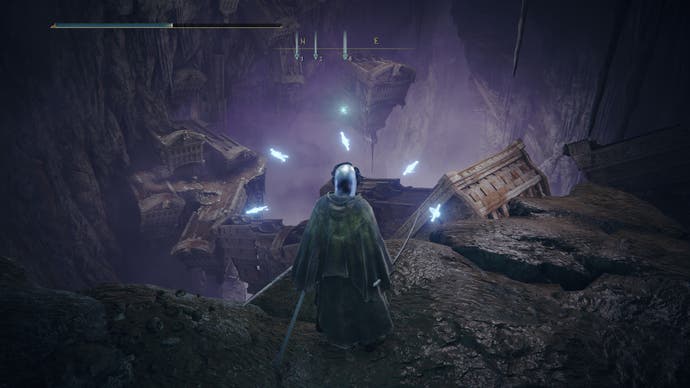
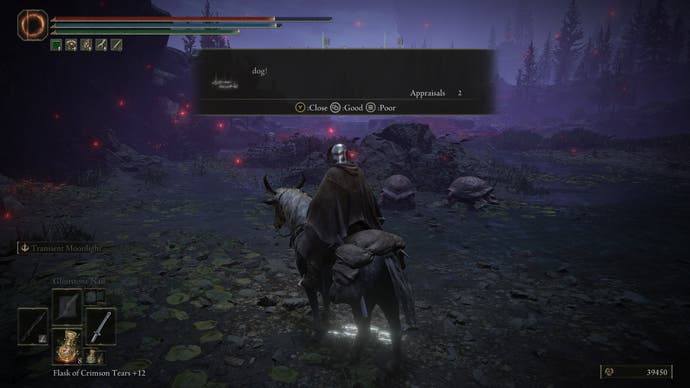
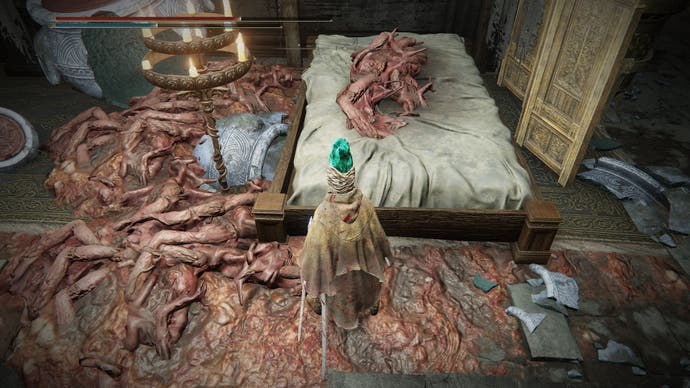
One of my biggest issues is how explicitly it abandons the core appeal of Elden Ring as a living text to be read and learned, and ambiently, lovingly communicated across realms.
It's true that this distinct type of FromSoft-engineered frustration is an indispensable part of the Souls experience – to hurl yourself repeatedly against a seemingly immovable object until through sheer luck and serendipitous timing, you somehow prevail. There is real palpable joy and pride and relief in that – we've all felt it, and with the blessing of hindsight, suddenly all of that failure feels like it was worth it. In other cases they're genuinely instructional, with real lessons learned. This, however, feels like difficulty for difficulty's sake, turned up to eleven, perhaps because with the added expectations of a DLC having something extra-absurd to conquer even though it technically doesn't require finishing the core game. I go through dozens of deaths over a period of several days, and despite taking breaks to go off and do other things and explore other areas, I realise that I just don't want to do this anymore.
In the Shadow Realm, death is always listening. I surf fleeting wavelets of euphoria as I dodge and roll away from ambushes, or groan in exasperation as I get sniped from a thousand miles away by a guy with a Radahn-sized chip on his bow shoulder. I devour Ymir's finger-subquest and root around for more bits of lore that deviate from the relentless Miquella fandom. I find an old, burned-out dragon warrior clearly modelled after Captain Ahab, who tasks me to defeat his own personal white whale – I love and pity this man, who is so close to howling "from hell's heart I stab at thee!" they might as well have given him a harpoon (I do have an extremely cool dragon-killing great katana). In Belurat, a hornsent grandam – an elder of the native people in the Shadow Realm – calls me a wanton strumpet with the same sort of dry spite as Diana Rigg's incredibly acerbic Lady Olenna from Game of Thrones. If George R.R. Martin exists in this DLC, it is almost certainly here.
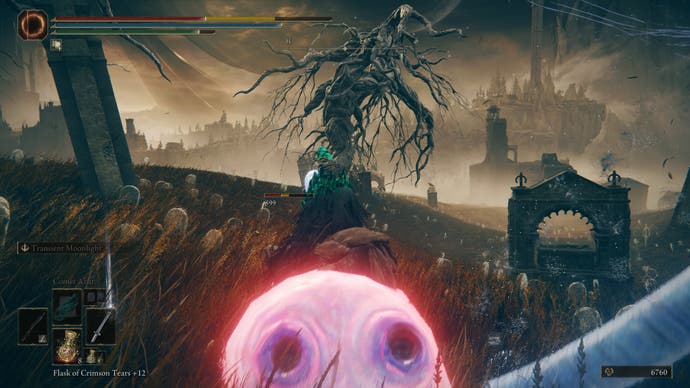
I become fascinated with a lone helmet dangling off a stick beneath a waterfall as a bit of environmental storytelling, and I return repeatedly to the Cerulean Coast just because I think it's pretty. I'm seriously thinking about re-speccing my Tarnished to a faith-focused build so I can play around with some of the new dragon incantations, which look genuinely cool. I do not think about going back to the final boss, but remain wary of narrative payoff one might expect after conquering that particular obstacle. I know in my heart that finishing Shadow of the Erdtree will be a very different, more joyful experience when I can play with functioning multiplayer, because navigating an open-world Souls game without that key component is the most pleasureless kind of masochism, which is extremely not for me. If you go back to that iconic anecdote about Miyazaki getting his car stuck in snow and having strangers help him, this is what Souls is all about – shared suffering, the community that rises up around it, and not having to freeze to death alone. I suspect that I may enjoy the DLC more when I reapproach it on my own terms, but it won't change the underlying problems I feel in its bones.
I am still impossibly fond of Elden Ring and my time spent in its grasp, but I'm just not sure if I can share the same fullness of warmth with Shadow of the Erdtree. Despite its strange dispersion of "active" areas, and uncharacteristically infantilising hand-holding for encounters that should be learned through repeated failure, Shadow still has its share of Elden Ring's brilliance – weird little dudes and obscure secrets and goofy cheesing and all. But perhaps trying to combine the inherent focus of a largely self-contained DLC, with the narrative flexibility and open-world freedom of Elden Ring – the concept that set it apart from its Souls brethren – was always going to make for an incongruous match.
A copy of Elden Ring: Shadow of the Erdtree was provided for review by Bandai Namco.
.png?width=690&quality=75&format=jpg&auto=webp)




